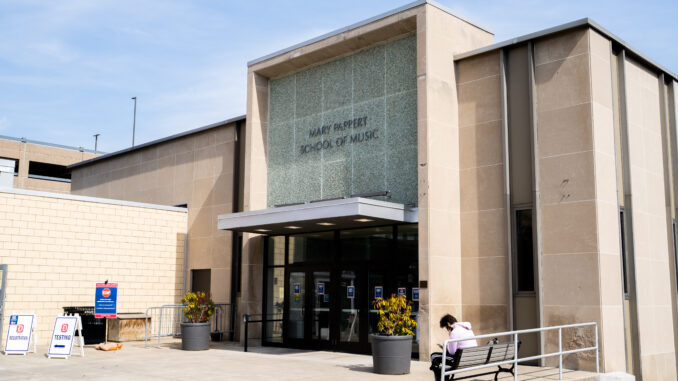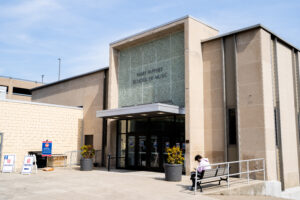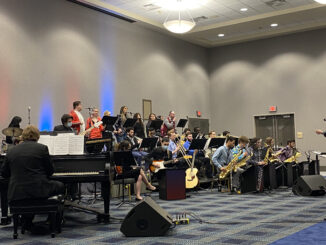
Capri Scarcelli | a&e editor
4/8/21

Music is the art of telling a story. In order to listen with an open mind, Duquesne University’s Mary Pappert School of Music has made an increased effort in culturally-responsive pedagogy — including a more diverse ensemble repertoire, carefully-crafted lesson planning and encouraging open conversation about the experiences of music’s students of color.
Dr. Caron Daley is Mary Pappert’s choral director for Pappert Chorale and Voices of Spirit, as well as assistant professor of music, ensemble coordinator and co-leader/founder of the Diversity, Equity, Inclusion & Access (DEIA) Taskforce.
This newly implemented organization attempts to survey students, faculty and staff on the music school’s overall approach to creating a comfortable, collaborative classroom environment that welcomes every voice.
According to Daley, culturally-responsive teaching is about “seeking to understand [students’] backgrounds, experiences and challenges in order to respond to what is going on in the world.”
“The choir is made up of an incredible diversity of individuals,” Daley said. “They come from different levels of experience with music and different cultural backgrounds. In order to be culturally-responsive to individuals in the choir, I try to get to know them. I try to build relationships with them and learn more about them.”
This semester, Daley asked her students if they considered themselves to be “culture bearers.” In a brief written assignment, students were asked to give background on their culture, offering choral pieces that could be used in the future for the ensembles to sing. In this semester alone for Voices of Spirit, Daley has included gospel, folk, French, Baroque and African spiritual pieces, with 50% of those pieces being composed by racially diverse female composers.
“The cultural representation of the class does affect how I choose repertoire, but then I also try to choose diverse repertoires beyond even what we may have represented in the class so that students could be exposed to different styles. That is an important part of musical education,” Daley said.
Freshman music education major Natalie St. Hill, a DEIA board member and Voices of Spirit singer, said that Daley does “a really great job” at “embracing and expanding the repertoire with different cultures.”
“One of our discussion board assignments during Black History Month was to find a different Black or African-American composer and talk about their choral music and a little background on it, which was really interesting,” St. Hill said. “We weren’t turning a blind eye to it. Dr. Daley said, ‘Let’s talk about it, and let’s talk about how it has to do with music.’”
Senior music therapy major Carlie Lalo, a University Singers member, said she was excited to hear that her native language would be represented in the song “Rosas Pandan,” a Filipino piece included in the spring concert repertoire for April 9.
“At first I was really surprised because that usually never happens,” Lalo said. “I had to ask my mom and she helped me with the pronunciations. I knew some of it growing up, but I was able to help the choir with it, which was really cool.”
Lalo also mentioned how she would like to see more Asian representation in required music therapy courses outside of choir.
“I feel like especially in music classes, my major specifically is not as diverse, and being of an Asian culture is not as seen in my major, and I feel like it would be important to talk about in class outside of just this choir class,” Lalo said.
Musicianship professor Dr. Benjamin Cornelius-Bates poses the question: How do we make classes accessible to those with different cultural experiences, and how do we broaden our horizons based on that?
“Oftentimes piano repertoire consists of old dead European white guys, such as Bach, Handel, Brahms, Mozart and Beethoven, where we hold these composers to a philosophical, mythic status,” Cornelius-Bates said. “We need to continue to expand and humanize this musical experience.”
Two years ago, Mary Pappert developed a history in hip-hop course, which dives into the global and cultural impact that this genre has had on the music scene. According to Cornelius-Bates, hip-hop has become the most-listened-to genre in the world, though Hollywood still holds ingrained cultural biases of the genre, which affects how it is addressed in an academic setting.
“We need to deflate that narrative. Racism is a white person problem,” Cornelius-Bates said. “I am a white person talking about Black culture, so re-writing the curriculum is hard, but it is absolutely necessary.”
“We need compassion, empathy, and to understand the perspectives of students so I can continue to adjust mine,” he continued.
St. Hill said she wishes she could take culturally-diverse courses such as jazz, hip-hop and opera workshop, though cannot due to the packed scheduling of the music education program.
“There’s just no room in our schedules right now because of the strict, 18-credit semesters,” St. Hill said. “A genre like jazz is not only important for cultural diversity, but also how [music education majors] are all going to be teachers at some point, and most public schools have a jazz band. Having a jazz background in Mary Pappert would help us expand that culture as well as expand our knowledge on its historical context.”
According to St. Hill, an issue with the education system is “getting [students of color] into the field.” Because of music boosters and differences in socioeconomic status, public education differs in opportunities for music programs, which may result in bad experiences for Black students if not given the opportunity to excel in high school.
“It’s a tricky thing. Public education wants to be more diverse with their representation, but a big thing is when you have Black or African American students going into education, a lot of them honestly don’t want to. I know that first-handedly, a lot of Black students have a hard time going through their educational journey. It’s hard to hire more Black educators when some have had those bad experiences,” St. Hill said.
To address these topics in the choral department, Daley invited composer Rosephayne Powell to a virtual rehearsal, where she discussed the stylistic interpretation of her piece “Still, I Rise,” as well as the challenges faced as a Black female composer in the composition field.
“It was really powerful. It was generous of her to join us on Zoom because I know she gets a lot of presentation requests,” Daley said.
Speaking on behalf of the choral department, Daley said she wants to continue to “exercise humility, sensitivity and examine historical practices.”
“I need to be willing to consider in what ways I have been exclusionary,” Daley said. “I took out gender names in the Pappert Men and Pappert Women’s Chorale two or three years ago because we have transgender students, we have students who identify as male but sing soprano and alto. This year, I got rid of uniforms in the choir to be sure that it is no longer a financial hurdle. I am taking small steps to continue to try to make the choirs more inclusive, and I just need to keep going in that direction.”
In a meeting through DEIA, all music majors gathered virtually on Feb. 17 to discuss the honest conversation of addressing diversity in the school of music and where the program can continue to grow.
“In music education, I am the only Black biracial student in my year,” St. Hill said. “In a predominantly white major, how do you appeal to more diverse people? I’ve had my fair share of moments where I was overlooked because of my race in high school. Here it’s different. Here I get more recognition and I get to start a new chapter. There’s more to me, and that’s something I really like about being here.”




